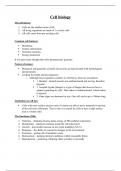Summary
IB Biology SL - the Complete Summary for the IBDP Exam
- Course
- Institution
- Book
This document is the complete summary required to pass the IB Biology Standard Level exams. It includes a detailed and comprehensive (yet concise) summary of Chapters 1-6 of the new textbook by Andrew Allott, as well as case studies you can mention during the exam, drawings and diagrams of relevant...
[Show more]





